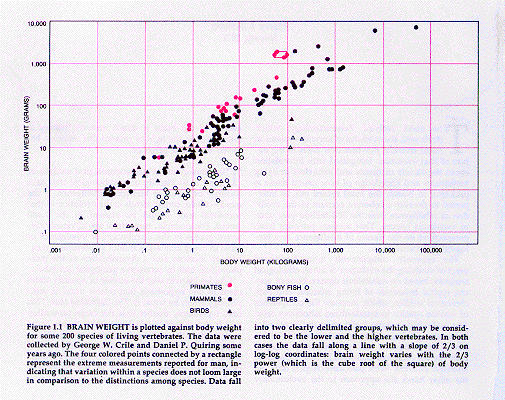Serendip is an independent site partnering with faculty at multiple colleges and universities around the world. Happy exploring!
Brain and Body Size, continued
Controlling for Body Size
Why are we looking at brain size and body size? What is the relationship?
Some may say that a larger brain means a more complex animal. If brain size indicates what capacity an animal has for processing information and coordinating the body, then perhaps those with larger brains can process more information, and thus are more intelligent.
What do you think? When we "controlled for" body size by making all the animals' body sizes equal, what happened? It seems to me that the human and porpoise brains were slightly larger than the brains of the other animals. It may be difficult to eye-ball, so here are two graphs that may help us out in this discussion:

These graphs (based on data from Jerison, 1973) represent a method for studying relative or proportional features among members of a taxon called "allometry". In this case, we are comparing brain weight/body weight ratios.

Look at the figure to the right. This shows data about relative brain size from a number of classes of vertebrates. Here the average weight of a brain in grams is plotted against the average weight of a body in kilograms (look at chart of brain/body sizes). Within this plot are groups of convex polygons which represent the outer boundary of a data set. Notice that there is a line running from the lower left to upper right through the two polygons. These lines represent the average, or best fit line, of all the data within that polygon.
What else do you see in this graph? The top surface, or outer limits, of the higher vertebrate polygon is set by animals that are usually thought to be most intelligent, i.e. humans, porpoises, and whales. Yet, generally the primates, which as a group are considered to be the "highest" (or most complex) vertebrates, have brains that, for the most part, are only somewhat above average for mammals (e.g., look for the gorilla and chimpanzee).
What do we make of all this? The elephant and the blue whale seem to set the most outer limits of the high vertebrate polygon. Does this mean that elephants and blue whales are the smartest animals on earth? There doesn't seem to be a whole lot of evidence for that. So, what we need to do now is completely factor out body size. This is often done by calculating how far each point is from the average line in the polygon. These numbers are called "residuals". These residuals can then be used to calculate an index of brain size relative to what would be predicted for an animal of that body size. These indices are called the "encephalization quotient", or EQ.
The EQ allows us to ask if the brain of a given species is bigger or smaller than would be expected. An "average" score is 1 and anything above that is assumed to indicate above average intelligence. Humans are most often at the top of this scale. Does this mean we are the most intelligent animals on the planet? How reliable do you think this method of allometry and EQ is for measuring intelligence? What is intelligence anyway? Is it reasonable to compare the intelligence of a crocodile with that of a whale or that of a human? Go here for a discussion about intelligence... or click on a button below.
Would you rather equalize the brain size of all the animals or learn about EQ and intelligence?





Comments
Post new comment